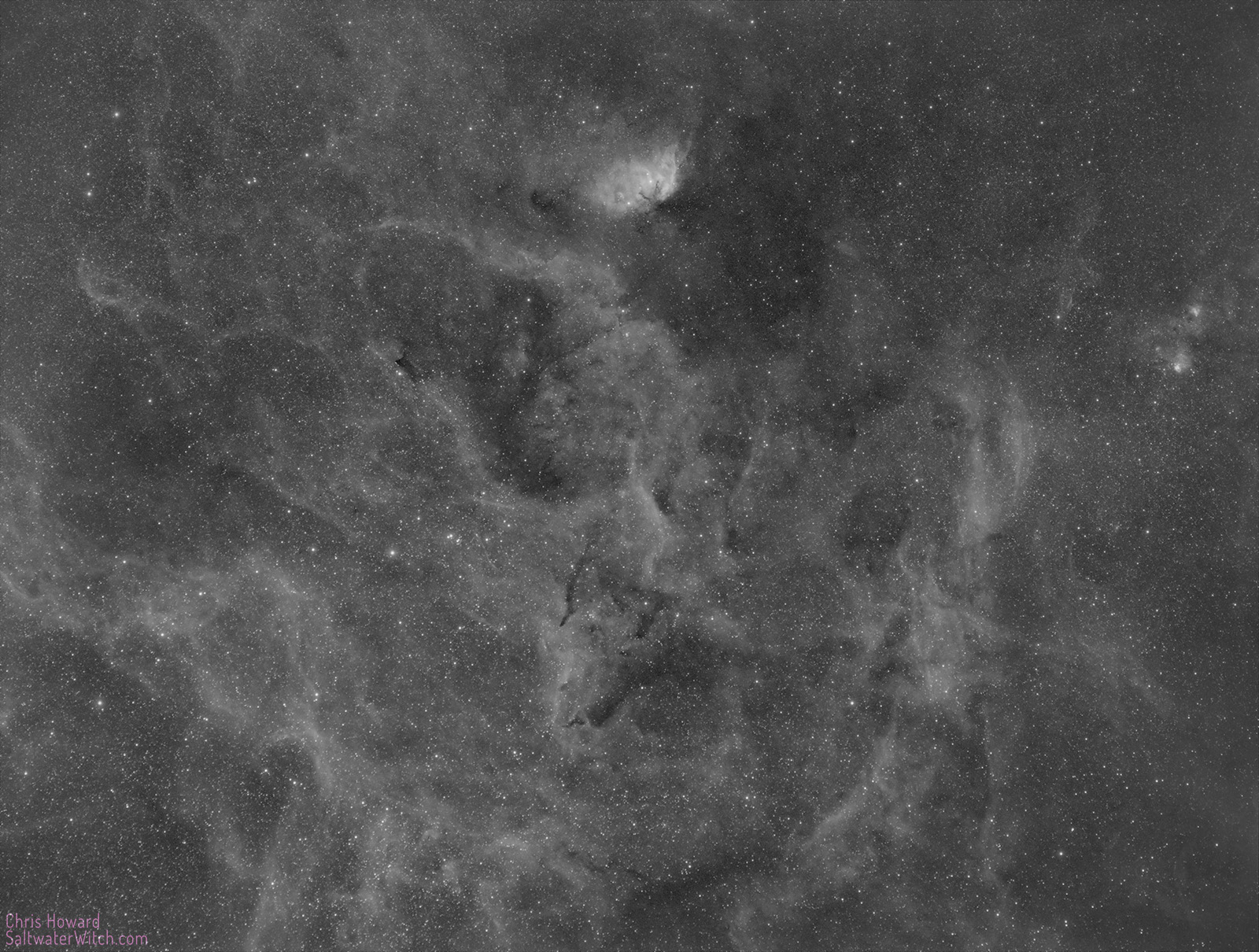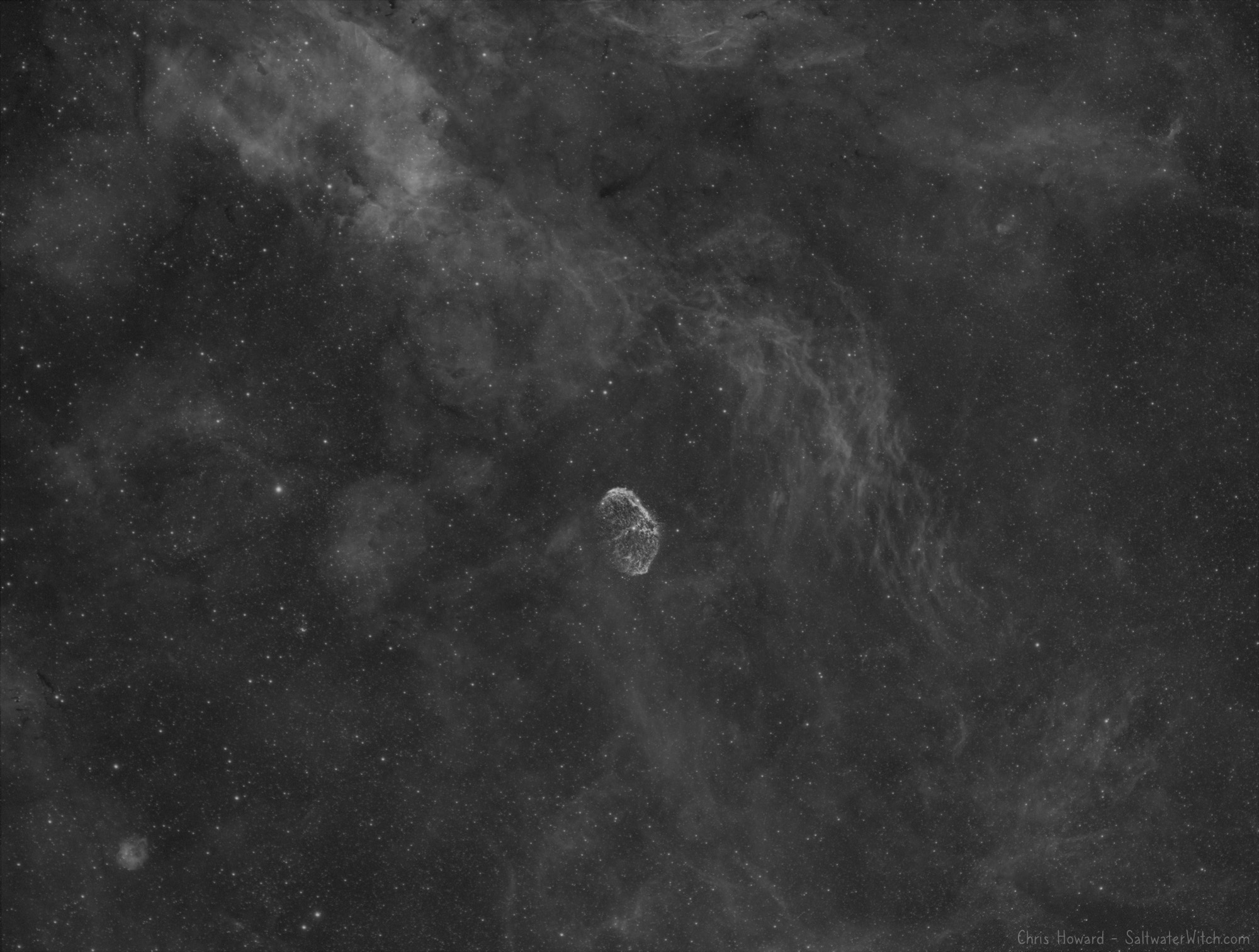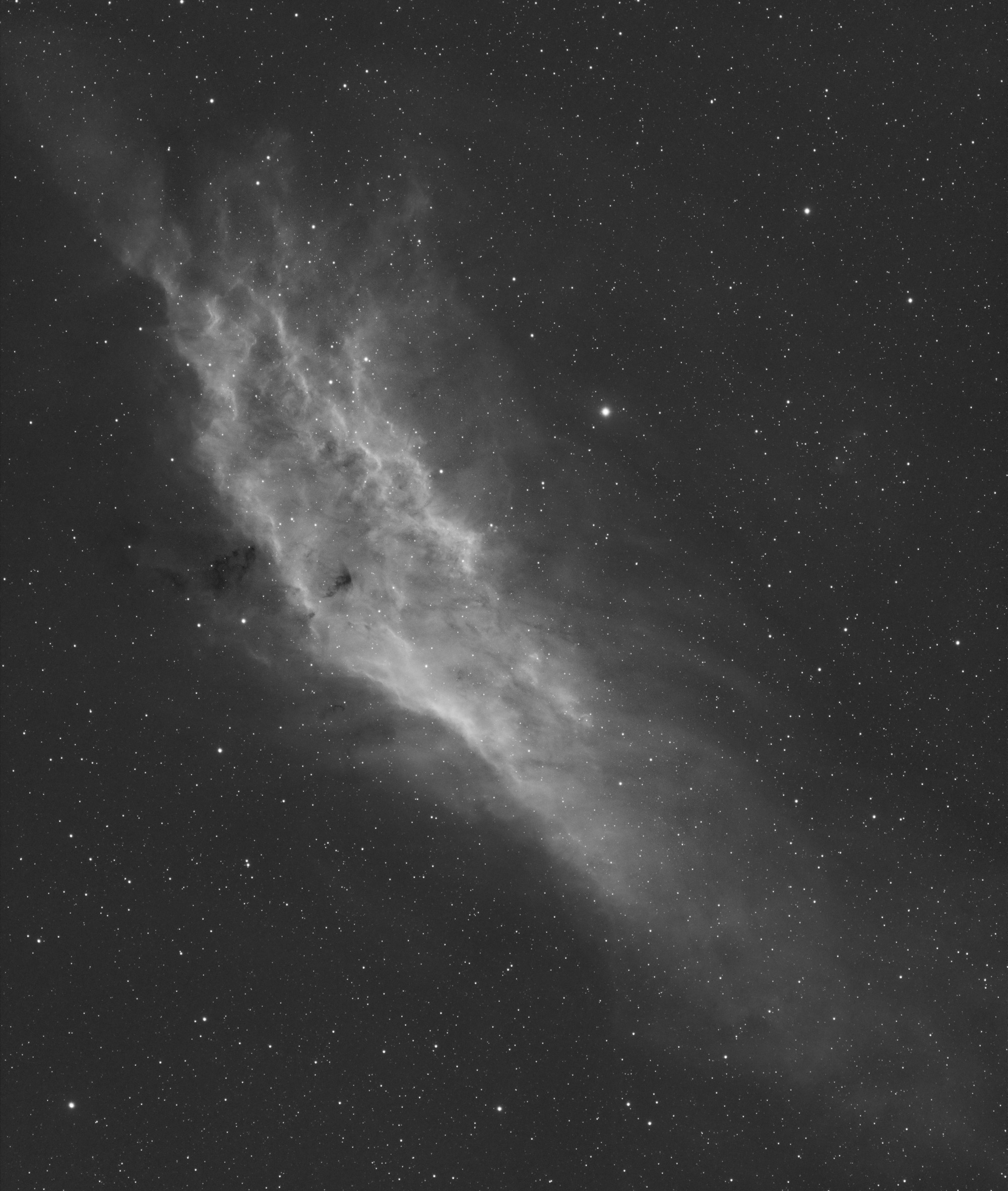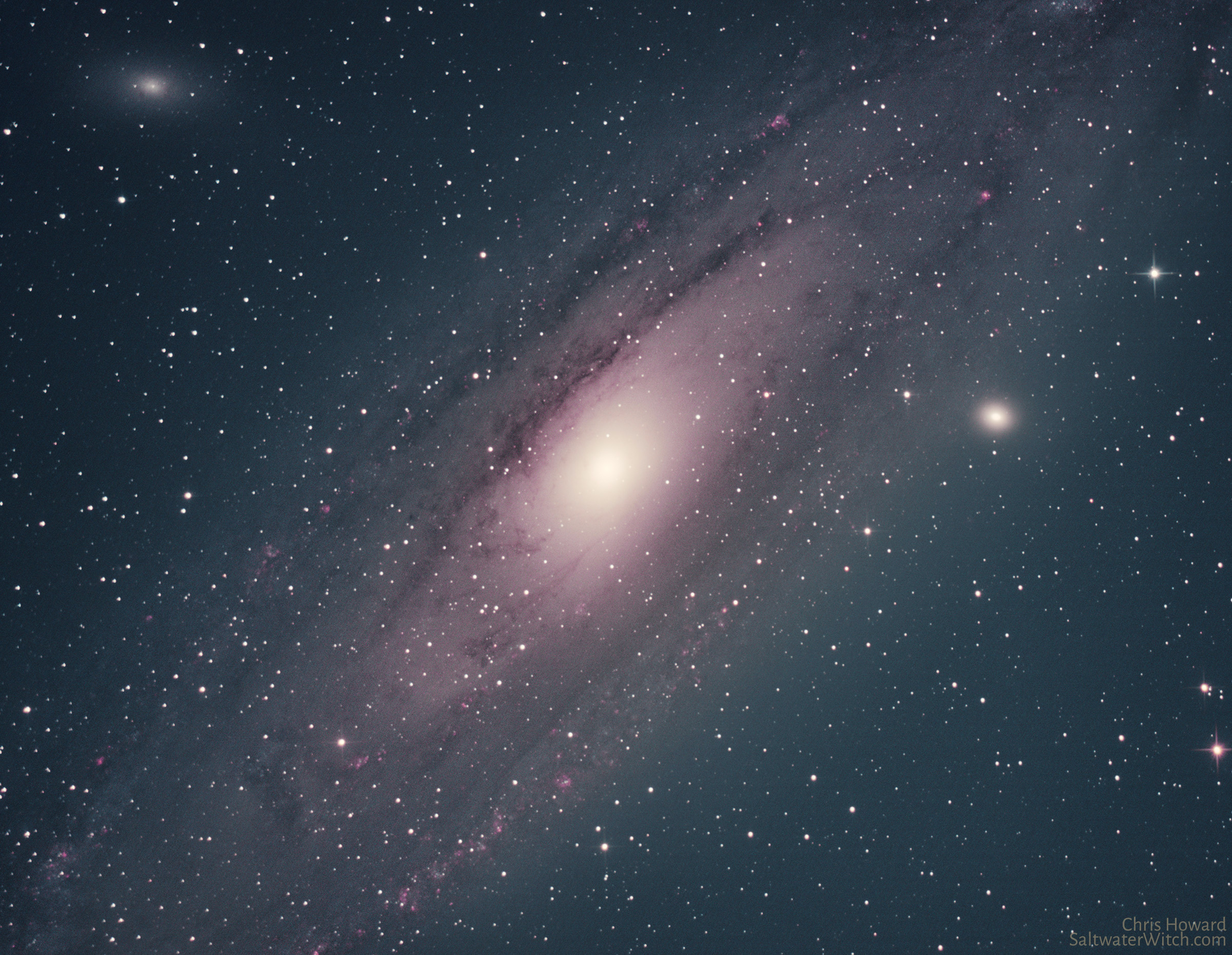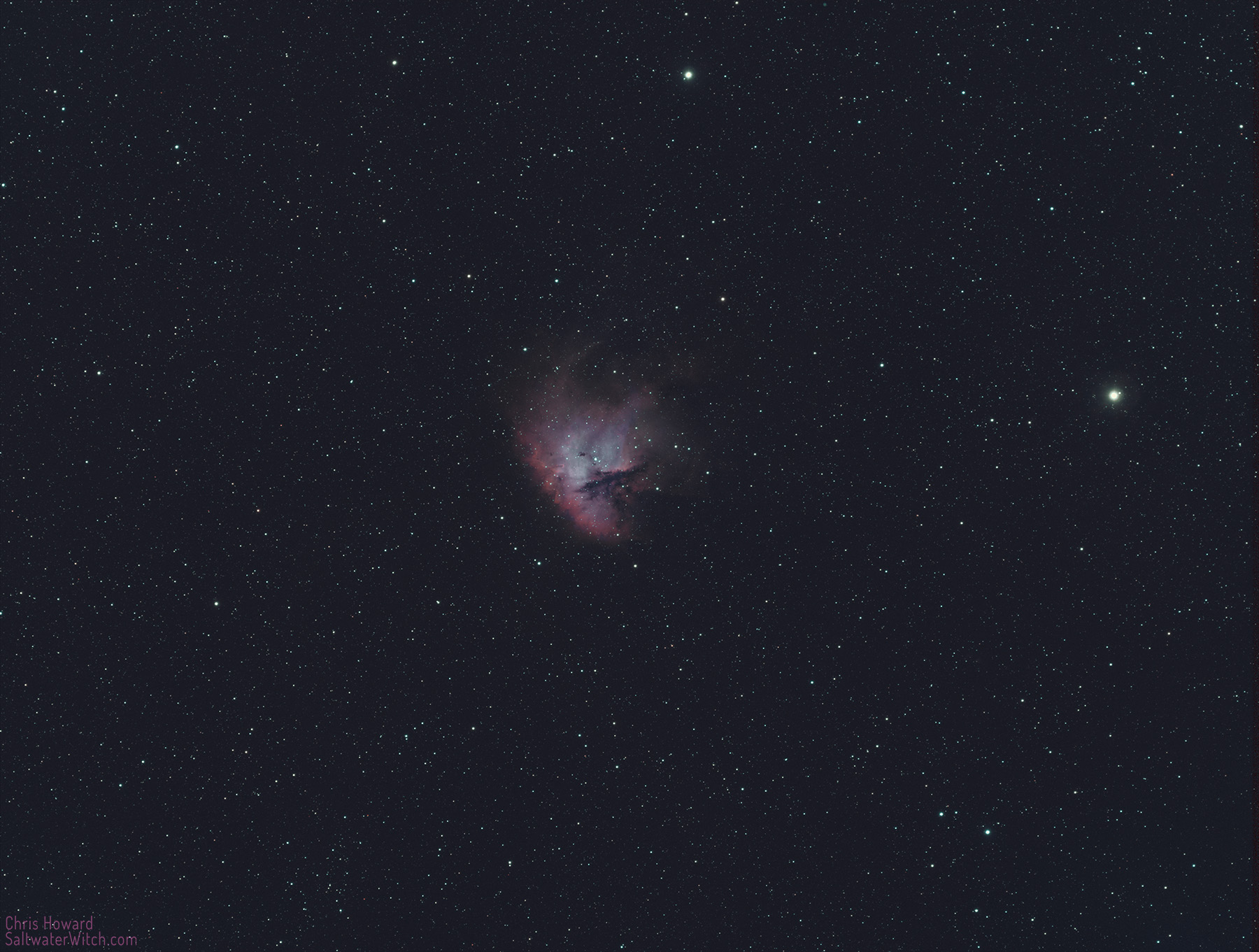The Crescent
NGC 6888, the Crescent Nebula in Cygnus, is mostly made up of ionized hydrogen with a filmy envelope of oxygen (not present in this Ha-only data). Its longest side spans about 25 lightyears, or about 235 trillion kilometers (146 trillion miles), which at only 5000 lightyears away, is a pretty good-sized deep sky object. I spent the entire night capturing hydrogen-alpha data, over 60 subs, 53 of which I used in this stack. I will come back on another night to capture the OIII data. Notes: William Optics SpaceCat51 apochromatic refractor, ZWO ASI1600MM-Pro monochrome camera cooled to -10C, 53 x 300-second subframes (about 4.5 hours of data) stacked in DSS, ZWO AM5 EQ mount, ASIAir Plus controller. (I ordered the ASIAir early August—backordered, and it arrived a couple weeks ago. This is only my second time out with the Air, and I can already see this being be my away-from-home controller).
Cropped to focus on NGC 6888 (above), here's the full FoV from the SpaceCat and ASI1600:
Posted September 17, 2022
Off to shoot the Wizard
NGC 7380 is an open star cluster in Cepheus, surrounded by the bright emission nebula Sharpless 142 (Sh2-142, center, left), but we all know it as the Wizard Nebula. Why? Well, because it sort of looks like a bent old dude with a pointy hat looking out over a vast expanse of nebulosity, loops of dark interstellar dust, and a spread of hot stars bathing everything in intense radiation, all of which could be mistaken for some sort of magical display. In other words, what a wizard might do. That's my guess, anyway.
Last night was also my first night out with the ZWO ASIAir Plus (astro device controller), and because the Wizard has all three bands present to some degree, hydrogen-alpha, oxygen 3, and sulfur 2, I thought I would try something new: shooting 10 subs for each filter, running autofocus for each set, and then looping through each set of three filters three times. This way I would end up with 30 sub frames for each over the course of one night, a reasonable amount of data. This would also allow me to see how the meridian flip went, how well the autofocus routines work, and more. Note: with the 3nm Antlia Pro narrowband filters, each autofocus run takes about 7 minutes, with a set of 20 second exposures—the routine needs at least 20 just get enough stars to focus with these very narrow 3 nanometer filters.
It was also a cool mid-September night and with wind gusts and "poor seeing" according to the Clear Sky Chart, the guiding with the ZWO AM5 wasn't outstanding, but good enough for 300-second exposures, never straying too far above an arcsecond.
Here's the combined narrowband result in SHO, the Hubble Palette, where Sulfur is mapped to Red, Hydrogen to Green, and Oxygen to Blue in RGB colorspace.
Here's the Hydrogen-alpha data by itself:
Posted September 16, 2022
NGC 1499 in Ha
The California Nebula (NGC 1499) in the constellation Perseus. Imaging notes: 3nm Antlia Pro hydrogen-alpha filter, William Optics SpaceCat 51 Apochromatic refractor, ZWO ASI1600MM-Pro monochrome camera.
Posted September 5, 2022
M31 and M33
I used the Optolong L-eXtreme for half of the exposures, filtering out everything except 7nm lines along hydrogen-alpha and oxygen 3, and then switched to full broadband, just the UV/IR Cut Filter. Notes: 8" 800mm f/4 Newtonian and the ZWO ASI071MC cooled color camera.
I'm not really a galaxy guy, more of a nebula guy, mainly because I don't have a scope over 1350mm, which is just long enough to get a handful of nearby galaxies. So, for now, I usually capture a couple of our galactic neighbors when they swing around this time of year--and if the moon and clear night skies line up for broadband color imaging!
The central region of M31, Andromeda Galaxy:
The Triangulum Galaxy from my backyard--it's only 2.73 million light-years from Earth! I've said it before. Once we develop MFTL technology (Much Faster Than Light) and we have the ability to hop to nearby galaxies, count me in on a trip to M33, the Triangulum Galaxy. The chunky pinkish masses are vast regions of interstellar ionized hydrogen that make up the nebulae in M33, perfect for an astrophotography outing. Until then, maybe we can take a trip to the southern hemisphere? Notes: Apertura 8" Newtonian OTA--800mm at f/4, ZWO ASI071MC cooled color camera. Optolong L-eXtreme dual narrowband filter. 48 x 240-second exposures stacked in DSS.
Posted September 4, 2022
Pacman
A wide-field view of the Pacman Nebula (NGC 281, IC11, Sh20184) in Cassiopeia (Ha + OIII), about 9500 lightyears away. The massive star on the right is α Cassiopeiae (or "alpha Cass" if you're on friendly terms) which makes up the right lower point of the W asterism of the constellation Cassiopeia. The bright star at the top is eta Cass, a binary star system that's only about 20 lightyears away from us, downright neighborly, and is not part of the W asterism.
Posted September 4, 2022
Cave Nebula, part one
The Cave Nebula (Caldwell 9) in Cepheus. I started the Ha run last night but Earth's atmosphere wasn't having any of it. Seeing was poor at best, and the random wisps of cloud passing through just made it worse. I stacked the first 30 subs just to see where it was going, and even with the excessive noise, I think this is headed in the right direction.
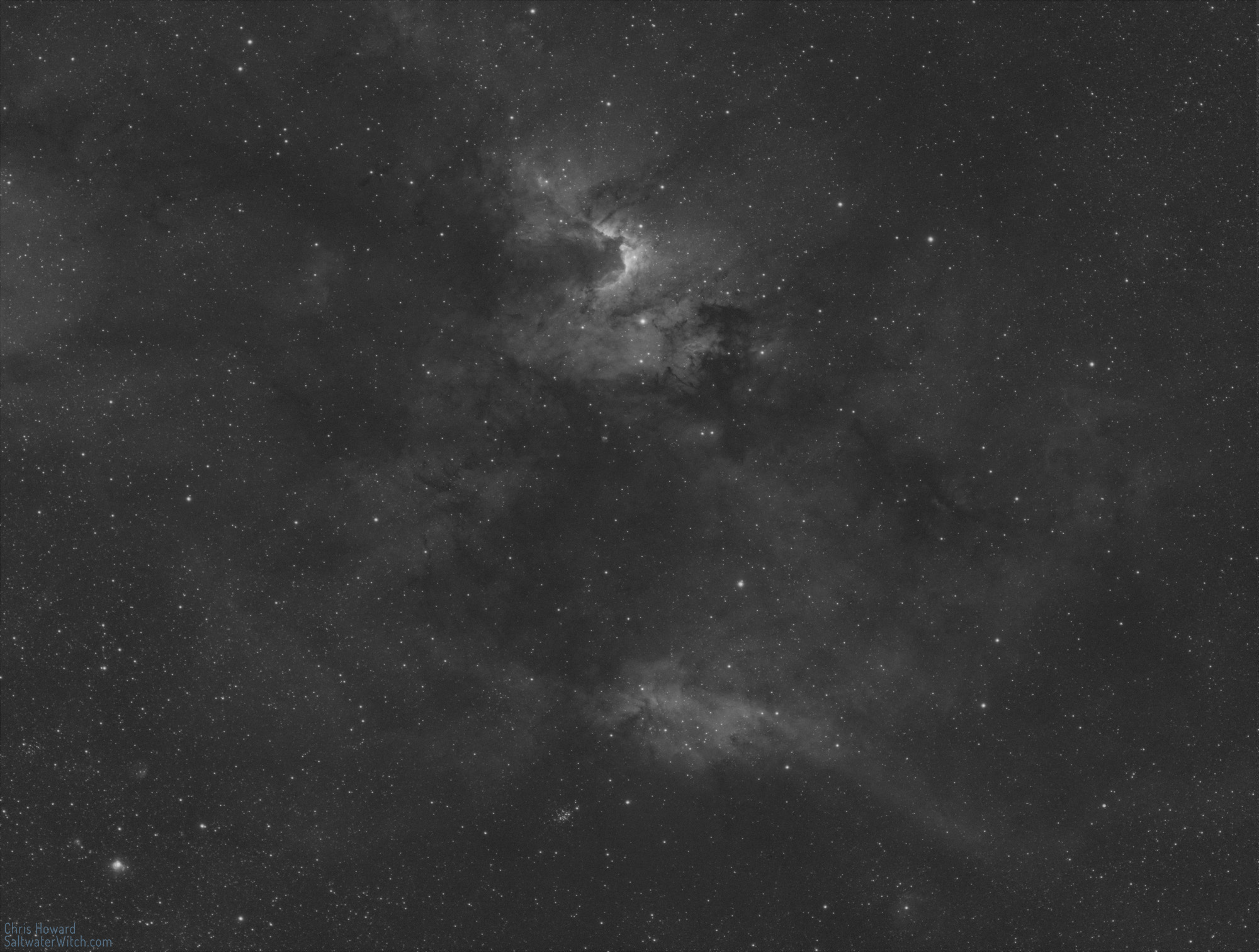
Posted September 1, 2022
After a week of clouds, the skies are clear enough for imaging
Right now, I'm in the middle of a 70 x 240 second Ha imaging run of sh2-157, the Lobster Claw Nebula in Cassiopeia and crossing the border into Cepheus. (I shot this with a Sony A7s, Zeiss Batis 40mm f/2 CF, 15 sec exposure, ISO 1600). That bright star in the center (out of focus—bokeh) is actually Jupiter.

Another one of the astro setup, this time with an Air Force tanker cruising in for a landing at Pease, just outside Portsmouth, in the background. (I think it was a tanker, going by the sound because I couldn't actually see anything but the lights. Pease is home to the 157th Air Refueling Wing).

I finished up the Lobster Claw Sunday night with some 3 nanometer Oxygen3 data. The Lobster Claw (Sh2-157), the Bubble Nebula, and so much more, extending over the border from Cassiopeia into Cepheus. The squarish bright region, Sh2-157a, at the joint of the top bluish arc of the Claw is a denser emission structure surrounding the Wolf Rayet star WR-157. The Bubble Nebula is middle top (NGC 7635, Sharpless 162, Caldwell 11), and the bright emission region below and to the right is NGC 7538. That cluster of stars above the Bubble Nebula is Messier 52 (M52). The Lobster Claw Sh2-157 is about 8000 lightyears away.

Posted August 28, 2022
Still Testing the AM5
Here's the Tulip Nebula (Sh2-101), top center, and some of the surrounding cloud structure in Cygnus. This is 23 x 240 second (4 minute) exposures in Hydrogen-alpha (6nm Astronomik narrowband filter), no calibration frames. I'm still testing out the new ZWO AM5 mount, and the Tulip is a nice deep sky target for Ha. Gear notes: William Optics SpaceCat 51 Apo refractor, ZWO ASI1600MM-Pro cooled monochrome camera.
